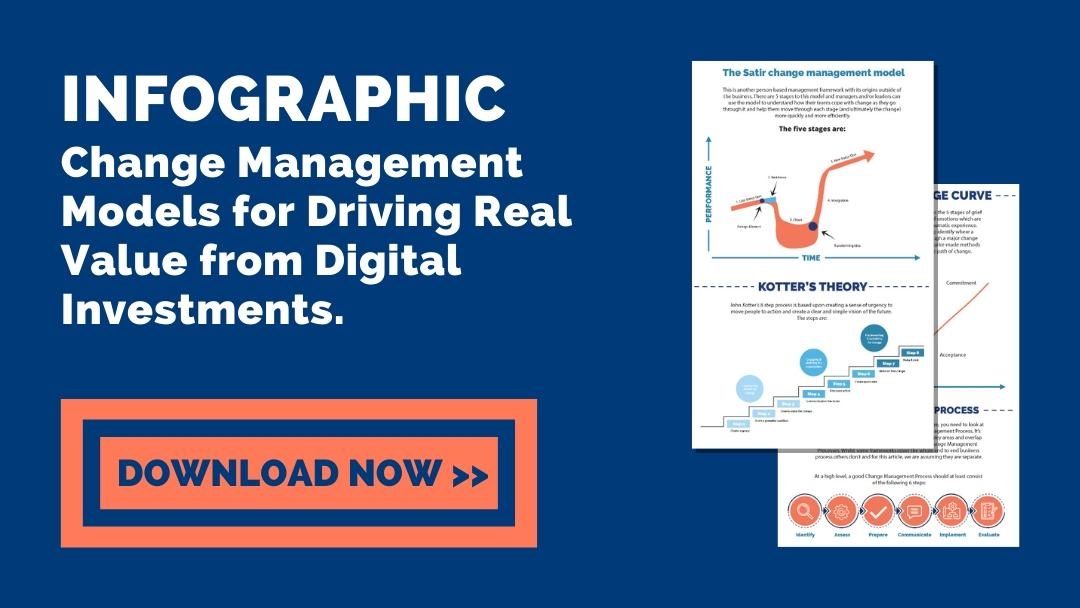
The terms “change” and “transformation” might sound very similar, but in the business environment they actually carry different meanings. Often, CEOs and CIOs don’t fully appreciate that they aren’t the same. While the business world has come a long way in learning how to manage change effectively, many people still struggle with the concept of transformation.
We’ve unpacked the terminology here so you can see at a glance what the important distinctions between them are.
Change Management vs. Transformation.
Both change and transformation are good (and necessary) for an organisation, but the goals, approaches, business processes and outcomes are different for each. Essentially, the purpose of change is to fix mistakes of the past, while the purpose of transformation is to create a new and improved future state. Notable differences between the two include:
#1: Focus.
Change management: In change management initiatives, the focus is on implementing specific, finite actions that result in a clear, well-defined shift in the way things are done. For example, if a large technology firm decides to add specialist engineering roles to regional teams, the change is likely to affect many people in terms of their workload, their designations, and in some cases even result in layoffs. To manage this effectively, a company can use change management practices such as:
- Making the business case for the changes
- Building an alliance of people with leadership qualities to champion the process
- Engaging all stakeholders including staff, vendors and customers
If the change management is handled correctly, the process should result in a smooth transition from the status quo to a new way of working that benefits all parties involved.
Transformation: Business transformation generally has a broader focus than change management. This could include a range of initiatives that intersect or have interdependencies. The goal is not usually to deliver a single, well-defined change, but to reinvent the entire organisation and discover new ways of working based on the strategic vision for the future. Digital transformation, for example, is currently sweeping through the business world as companies strive to keep pace with changes in technology.
Transformation is less predictable and more experimental than organisational changes, and it carries a higher level of risk during the process. Change management is an essential component of transformation, but unless it’s properly carried out, the overall transformation could fail.

#2: Scope.
Change management usually applies to specific initiatives, which can either be small and incremental, or they can be large and complex. The scope of the changes can affect the entire organisation, or impact only a particular department or function. Either way, organisational change can’t be implemented and then forgotten about, but needs to be constantly monitored and maintained. It takes a mindful, external effort to keep the changes on track and sustainable.
Transformation, however, is a company-wide process that affects the entire philosophy of the company and the way it does business. It’s almost always a major undertaking, which works by using external influences to change company belief systems. The actions of staff and management then adapt to achieve the desired results naturally.
Characteristics of Change Management vs. Transformation.
Since change is intended to fix past problems and mistakes, some of the characteristics of a change management program include:
- An assessment of the current situation and the problems or issues that need attention.
- Evaluation of the past and present that you can use as a benchmark to measure the success of the changes.
- Actions that are required to achieve the new results you want.
- Adjustments that usually make things faster, cheaper or more efficient.
The overall result of a successful change is that your company, team or product becomes a better version of itself—not a new version.

Transformation, in both digital and other senses, aims to identify a new and different future state for the company, its people and products. Instead of making the system better, the point is rather to create a new and better system.
- Transformation begins with analysing where you want to go, which helps to direct your actions. Often, the envisioned future is completely different from the past.
- Your leadership team then designs what you want the company to look like in a few years and conceptualises how to get there.
- The need for transformation often arises because of resistance to change, and it comes about when the change needed reaches a magnitude that can’t be resolved in small, incremental steps.
- Transformation usually depends on successfully executing multiple change management initiatives.
The real difference lies in the distinction between change management and cultural transformation. The outcome of the first is better ways of doing what you currently do. The outcome of the second is that your company, team or product is completely redefined based on your objectives for the future.
Companies across the globe are rapidly starting to realise that the old, analogue ways of working need to be completely replaced with new, digital methods. Making finite changes isn’t going to get you there—a major initiative will be necessary to overcome the barriers to digital transformation, to take an outdated business operation into the new technological era.

